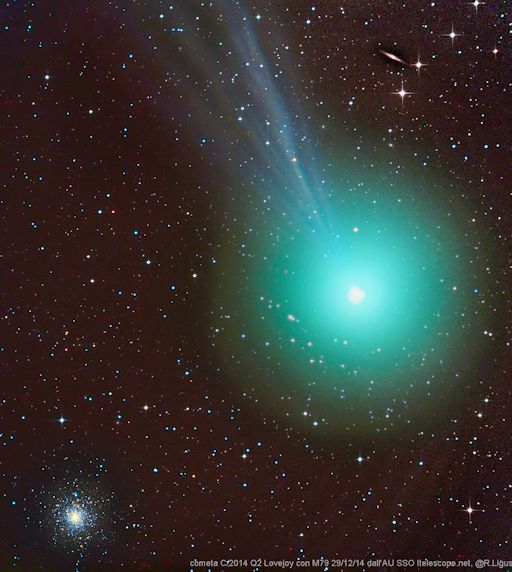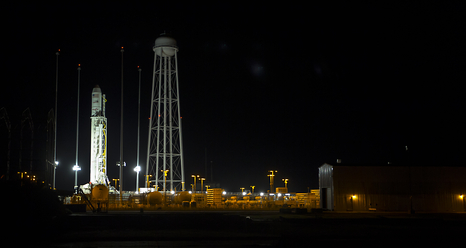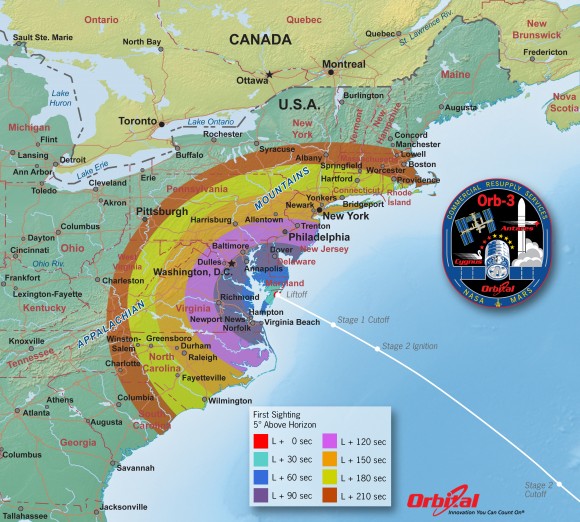10:00 AM | Comet Lovejoy rings in the New Year!
Paul Dorian
 [Image of Comet Lovejoy on 12/29/14; courtesy "spaceweather.com"]
[Image of Comet Lovejoy on 12/29/14; courtesy "spaceweather.com"]
Discussion
Comet Lovejoy is just now becoming visible to the naked eye in the northern hemisphere and it is expected to more than double in brightness by mid-January. Currently, the comet shines at magnitude +5.0 and can be seen in dark sky conditions as a fuzzy patch near Orion’s belt several hours after sunset. This is the fifth comet discovered by the Australian astronomer Terry Lovejoy – officially named C/2014 Q2 - and it will pass about 70 million kilometers (44 million miles) from the Earth on January 7th with its peak brightness expected to reach around 4th magnitude which should be pretty easily visible without any optical aid. The location of Comet Lovejoy will be a bonus as it should be relatively easy to find near the constellation of Orion. It’ll also glide past Taurus and the Pleiades over the next few weeks. The comet is moving to the north so it is getting higher all the time for Northern Hemisphere observers.
By January 7th – the time of closest approach – the nearly full moon will make it tougher to see, but after that the moon will rise late enough that it won’t be as big of a problem. In the photo (above) the comet-head appears green and the tail appears blue; however, those colors will likely not be apparent to the naked eye. These colors come from ionized carbon monoxide (CO+) and diatomic carbon (C2), which glow blue and green, respectively, in the near-vacuum of interplanetary space. Long exposure photography tends to bring out the green hue in the comet-head. As for the physical nature of the comet itself, it’s on a pretty long-period orbit, taking about 14,000 years to go around the Sun. The orbit takes it out to a distance of nearly 90 billion kilometers (for comparison, Neptune orbits at a distance of 4.5 billion kilometers).
Finder charts for January can be found here courtesy "Sky and Telescope": http://www.skyandtelescope.com/wp-content/uploads/Lovejoy2_BW.pdf Also, another web site that can help in the location of the comet can be found at http://heavens-above.com. Simply follow the instructions at this web site by entering your observing location under "Configuration" (Philadelphia is close enough for all of SE PA) and then enter Comet Lovejoy under "Astronomy" for a particular time.

 PHOTO: Comet 67P/Churyumov-Gerasimenko is seen in a photo taken by the Rosetta spacecraft with the OSIRIS narrow-angle camera August 3, 2014.
PHOTO: Comet 67P/Churyumov-Gerasimenko is seen in a photo taken by the Rosetta spacecraft with the OSIRIS narrow-angle camera August 3, 2014. [Antares rocket on launch pad this weekend]
[Antares rocket on launch pad this weekend] [Another view of the Antares rocket]
[Another view of the Antares rocket] Orbital 3 Launch from NASA Wallops Island, VA on Oct. 27, 2014 - Time of First Sighting Map. This map shows the rough time at which you can first expect to see Antares after it is launched on Oct. 27, 2014. It represents the time at which the rocket will reach 5 degrees above the horizon and varies depending on your location. As an example, using this map when observing from Washington, DC shows that Antares will reach 5 degrees above the horizon approximately 117 seconds after launch (L + 117 sec). Credit: Orbital Sciences
Orbital 3 Launch from NASA Wallops Island, VA on Oct. 27, 2014 - Time of First Sighting Map. This map shows the rough time at which you can first expect to see Antares after it is launched on Oct. 27, 2014. It represents the time at which the rocket will reach 5 degrees above the horizon and varies depending on your location. As an example, using this map when observing from Washington, DC shows that Antares will reach 5 degrees above the horizon approximately 117 seconds after launch (L + 117 sec). Credit: Orbital Sciences
 [Northern lights visible last night in Arizona from the initial CME; photo courtesy spaceweather.com]
[Northern lights visible last night in Arizona from the initial CME; photo courtesy spaceweather.com] [Impact on NASA's ACE spacecraft just a short time ago (arrow) from the arrival of the second CME; courtesy NOAA/Space Weather Prediction Center]
[Impact on NASA's ACE spacecraft just a short time ago (arrow) from the arrival of the second CME; courtesy NOAA/Space Weather Prediction Center]

 [Sunspots sketched by Richard Carrington on Sept. 1, 1859. Copyright: Royal Astronomical Society]
[Sunspots sketched by Richard Carrington on Sept. 1, 1859. Copyright: Royal Astronomical Society] ["Bloody red" moon during a total eclipse in December 2010]
["Bloody red" moon during a total eclipse in December 2010]